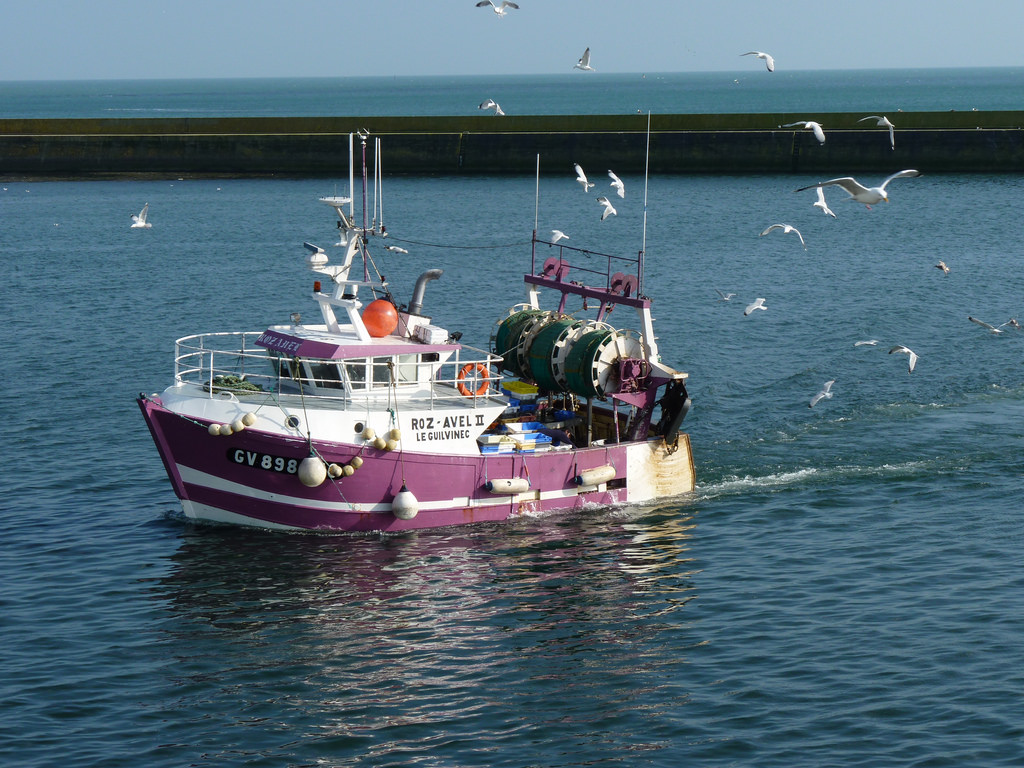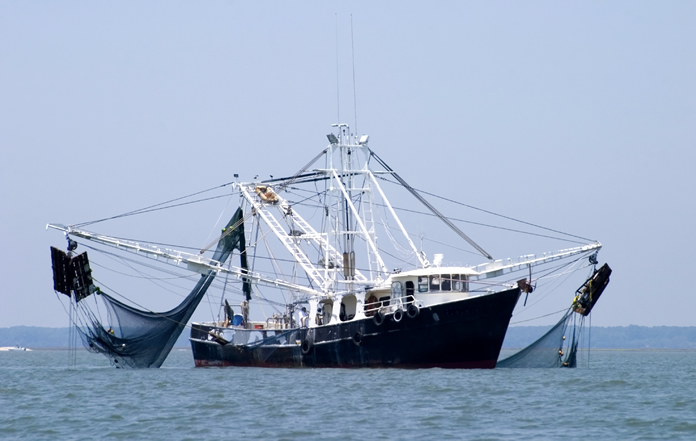 |
| Fishing boat |
Fishing regulations are government restrictions on where and how fish may be caught. Typically fishing regulations address the time of year, place, and how many fish of a certain type of fish may be caught. Commercial fishers have to follow many fishing regulations. A commercial fisher is a company that seeks to make a profit from the sale of fish.
Commercial fishing regulations are necessary
Worldwide, one out of every five people relies on fish as their primary source of protein. A decrease in fish populations could lead to malnutrition in human populations. Fishing is also economically important, as over 200 million people work in the fishing industry. Fishing regulation seek to minimize the decrease in fish populations and harm done to the ocean environment.
Overfishing. Until the mid-1800s humans did not have the ability or the need to catch extremely large numbers of fish.Advancements in fishing capabilities and technology changed this situation. In the mid-nineteenth century, steam powered ships began to replace sailboats. Steam ships could travel faster and remain at sea for long periods, catching more fish than sailboats. In the twentieth century, diesel powered ships replaced steam ships. Diesel ships could travel faster and farther than steam ships.
  |
Steel and iron replaced wood as the primary building material for ships after about 1850. The use of steel and iron allowed ship builders to make larger ships capable of storing more catch. By 1950 fishing ships had become large, fast ships that could remain at sea for months at a time. These fishing ships used refrigeration to keep their enormous catches fresh for the voyage home. The invention of refrigeration and freezing units also allowed fish to be sent to areas far inland. Before refrigeration, only people who lived close to the coast could eat fish.
The ability to catch larger numbers of fish and the increased market proved to be an unfortunate combination for many species of fish. In the 1990s the populations of cod, haddock, and flounder in the North Atlantic Ocean fell by over 90%. Cod fishing off the Canadian waters was restricted by law in order to encourage the species to rebound in numbers but as of 2004, the cod population had not recovered.
Overfishing is one of the largest threats to the ocean ecosystem in the twenty-first century. An ecosystem is a community of plants, animals, and other organisms that interact with each other and with their physical environment. Overfishing occurs when fish are caught faster than they can reproduce.
Overfishing results in a loss in number of fish and threatens many species of fish with extinction (disappearance). A species is a group of organisms that have a unique set of characteristics, such as body shape and behavior, and that can reproduce. Around the world, scientists estimate that more than half of all fish species that humans use for food are overfished.
 |
| Fishing vessel |
Overfishing also contributes to the destruction of habitat. Many fishing methods destroy coral reefs. A coral reef is a tropical marine feature created by numerous colonies of tiny coral animals. Many different species of fish live in coral reefs. Once a coral reef is destroyed many marine animals die.
Pollution. Pollution also threaten many species of fish with extinction. Pollution destroys or alters the habitats of many species of fish. This kills fish, because they lose their sources of food, shelter, and protection.
Despite regulations to control ocean pollution adopted by most developing countries, pollution still threatens the survival of many species of fish. Pollution usually does not directly kill most species of fish. Pollution destroys food sources that the fish rely on for survival. When the primary food source for a species decreases, the population of that fish species will also decrease. The decrease in food supply also forces the surviving members of that species to look for food in new areas. This may put that species in competition with other fish species for the same food supply.
   |
Destruction of coral reefs
Coral reefs are an important habitat for many marine species. Coral reefs abound with many different species of marine plants and animals. Coral reefs only cover about 0.2% of the world’s oceans, yet they contain 25% of the marine plant and animal species. Most of the world’s large coral reefs lie near Australia, the United States, and in the Caribbean.
Overfishing has had a major impact on coral reefs. Commercial fishing operations naturally want to go to the places where they can catch the most fish, and often choose to fish near Fishing regulations Overfishing, pollution, and loss of habitat all contribute to a dangerously quick decrease in fish populations.
A population decrease of a particular species may strain the population (reduce the numbers) of other fish species. Each marine animal plays an important part in the food chain, which is an important factor for biodiversity (variety of living organisms). The food chain is a sequence of organisms in an ecosystem in which each member feeds on the member below it. The animals near the top of the food chain rely on the animals near the middle of the food chain for food.
In order to prevent overfishing, in the 1990s, the United Nations and individual nations began to take action. The United Nations is an association of countries founded in 1945 that is devoted to the promotion of peace, security, and cooperation between nations. The United Nations and many countries began to pass two types of commercial fishing resolutions: no-take zones and fishing limits.
No-take zones. A no-take zone is an area of the sea where no fishing may take place. No-take zones are usually created to protect a certain species of fish in its natural habitat. The coral reefs. Coral reef ecosystems evolved over millions of years to achieve a balance within the food chain. When overfishing upsets this ecosystem, the entire coral reef ecosystem could collapse.
Some of the world’s most sensitive coral reefs are in developing nations with few fishing regulations. In these nations, commercial fishers often use dynamite to create an explosion on the bottom of the reef, stunning vast numbers of fish and causing them to float to the water surface for an easy catch. Dynamite fishing destroys plants and coral, as well as fish.
Fishing regulations
Overfishing, pollution, and loss of habitat all contribute to a dangerously quick decrease in fish populations. A population decrease of a particular species may strain the population (reduce the numbers) of other fish species. Each marine animal plays an important part in the food chain, which is an important factor for biodiversity (variety of living organisms). The food chain is a sequence of organisms in an ecosystem in which each member feeds on the member below it. The animals near the top of the food chain rely on the animals near the middle of the food chain for food.
In order to prevent overfishing, in the 1990s, the United Nations and individual nations began to take action. The United Nations is an association of countries founded in 1945 that is devoted to the promotion of peace, security, and cooperation between nations. The United Nations and many countries began to pass two types of commercial fishing resolutions: no-take zones and fishing limits.
No-take zones. A no-take zone is an area of the sea where no fishing may take place. No-take zones are usually created to protect a certain species of fish in its natural habitat. The United Nations has had limited success in establishing no-take zones, also called marine protection areas, due to the numbers of countries who oppose them because the country’s citizens depend on fishing for their living. As a result of this opposition, less than 1% of the world’s oceans are included in a United Nations Marine Protection Area.
In some areas where no-take zones have been established, certain fish populations have recovered quickly. In the Florida Keys National Marine Sanctuary, no-takes zones were established in 1997 for the spiny lobster, and for the yellowtail snapper and grouper, both reef fish. By the end of 1998, all three species had shown significant increases in their populations, and the coral reef in which they live showed increased vitality.
Fishing limits. The creation of fishing limits has been a more popular solution to overfishing than no-take zones. Unlike no take zones, limits do not completely ban fishing within a certain area, but seek to conserve fish populations by restricting when a species of fish may be caught and limiting the size of the catch. Fishing limits also prohibit catching a fish before it reaches a targeted size. This provides the fish an opportunity to reproduce before being caught.
In order for fishing limits to be effective, the governing agency must rely on accurate scientific data. Fish populations are closely monitored and if the population of a certain species shrinks, additional limits may be placed for that species. If populations recover, catch limits may be raised for the monitored species.
Limits often restrict the time of year when a certain species can be caught, creating a season for the fishing of monitored species. These restrictions are usually based on the breeding season for that species of fish. Fishing limit regulations also create a total weight limit that may be harvested within a season. When calculating the weight, all of the fish caught by all fishers is taken into account. Once the weight limit is met, the season on that species is closed.
While fishing limits are usually set by individual nations, fish do not remain in one place. Large schools (groups) of fish can migrate (periodically travel) over great distances that might take them from the waters of one nation to the waters of another. Overfishing by one country can affect fishing in other nations. The United Nations addressed this issue by passing the Agreement on Straddling Fish Stocks and Highly Migratory Fish Stocks. This treaty, which went into effect December 2001, limits the amount of fish that nations can take from large schools of fish that may travel to the waters of other countries.
In order to prevent pollution and habitat loss from commercial fishing, in 1982, the International Maritime Organization put into practice an agreement known as MARPOL 73/78. Part of the MARPOL agreement banned fishing boats from discharging sewage, garbage, and other substances identified as noxious (harmful) into the sea. Broken and used fishing gear are classified as garbage and cannot be dumped into the sea, where they could hook untargeted fish species or, in the case of some nets, become entangled and damage an entire local habitat such as coral.
Freshwater fishing regulations
Commercial fishing regulations on species of freshwater fish are not as common as regulation on marine fish. Freshwater fish are usually not overfished by commercial fishers, as freshwater fish usually do not travel in huge schools and large fishing boats cannot travel easily on rivers. Most regulations to protect freshwater fish involve pollution control, destruction of habitat, and limiting catches in specific lakes or rivers by individuals.
